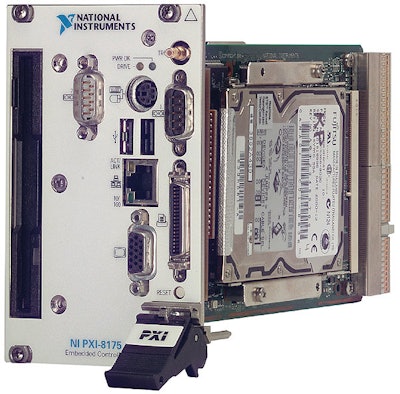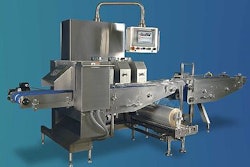In custom-building a pressure-sensitive top-seal labeling system for canisters of powdered beverage mix, Innoventor Solutions came up with a way to use a single programmable Automation Controller (PAC) to tightly integrate motion, vision, and logic. The PAC is National Instruments’ PXI platform, an eight-slot chassis that includes National Instruments’ 8175 CPU.
This controls solution combines the functionality of a PC and the reliability of a PLC, says Sam Hammond, Innoventor chief engineer. And because the PAC is run by National Instrument’s LabView software, a single programming language is used for motion, vision, and logic. That reduces cost and makes fewer programming demands on personnel responsible for keeping the machine running.
The p-s top-seal label at the heart of this application is placed over the top of each canister’s press-fit closure. The label used to be applied manually, but this was too slow and ergonomically undesirable.
Automating the operation was made especially difficult because the canisters have to move through the labeling operation in multi-flavor rather than single-flavor groups. The top-seal label is the same for all flavors in the group, but sidewall graphics and location of bar code vary from flavor to flavor. That meant that any attempt at automation had to include canister orientation. Otherwise, the top-seal label, whose “wings” extend an inch or so down the canister sidewall, might cover sidewall graphics.
The solution Innoventor came up with is designed around a six-platform rotary indexing table. Mounted above it is a p-s labeling head from Universal Labeling Systems. The PAC’s challenge is to synchronize a) infeed of canisters onto and off of the rotary turntable, b) scanning of canisters to locate and read bar codes, c) rotation of canisters for orientation, d) firing of the labeling head, e) discharge of labeled canisters, and f) sortation of discharged canisters based on bar codes.
The labeling sequence is initiated by a custom-built pneumatically powered robotic device with a mechanical end effector that picks a canister from an infeed conveyor and places it on one of the six platforms on the rotary table. When the table’s rotation brings a platform to the system’s vision station, the table pauses so that three digital cameras can capture images of the canister. If the bar code on the canister can’t be located or read, a stepper motor rotates the canister by a 60° increment for a new camera view. Once the bar code can be read, its position is sent to the PAC, which uses “look-up tables” to tell the stepper motor how far to rotate the platform for perfect canister orientation. The top-seal label is applied and the labeled canister is removed from its platform by a robotic device like the one used to initiate the labeling sequence.
The average cycle time for each label applied is 1.4 sec. That permits nearly 50% greater throughput than when operators were applying the top-seal labels by hand. An added benefit is increased consistency in the placement of the top seal labels. This prevents the possibility of a top-seal label obscuring part of the canister’s main body label.






























